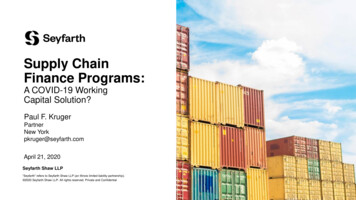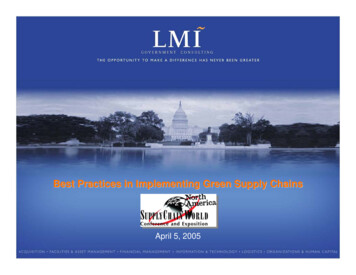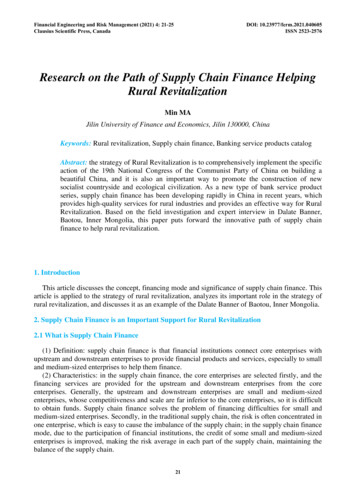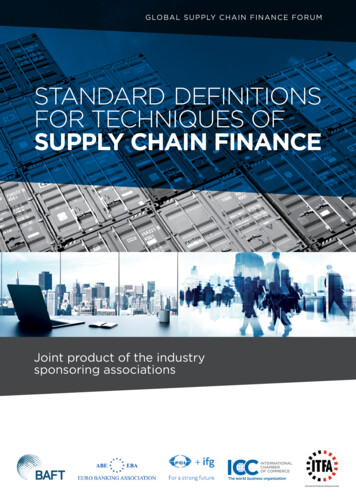
Transcription
Supply ChainFinance Programs:A COVID-19 WorkingCapital Solution?Paul F. KrugerPartnerNew Yorkpkruger@seyfarth.comApril 21, 2020Seyfarth Shaw LLPSeyfarth Shaw LLP“Seyfarth” refers to Seyfarth Shaw LLP (an Illinois limited liability partnership).“Seyfarth” refers to Seyfarth Shaw LLP (an Illinois limited liability partnership). 2020 Seyfarth Shaw LLP. All rights reserved. Private and Confidential
Legal DisclaimerThis presentation has been prepared by Seyfarth Shaw LLP forinformational purposes only. The material discussed during this webinarshould not be construed as legal advice or a legal opinion on any specificfacts or circumstances. The content is intended for general informationpurposes only, and you are urged to consult a lawyer concerning your ownsituation and any specific legal questions you may have.Seyfarth Shaw LLP“Seyfarth” refers to Seyfarth Shaw LLP (an Illinois limited liability partnership). 2020 Seyfarth Shaw LLP. All rights reserved. Private and Confidential
Agenda010203OverviewStructuresCurrent Issues 2020 Seyfarth Shaw LLP. All rights reserved. Private and Confidential3
Supply ChainFinance Programs- Overview 2020 Seyfarth Shaw LLP. All rights reserved. Private and Confidential4
Background The “instrumentation” of trade finance has undergone a period of rapidinnovation – the physical handling of documentary evidence isdisappearing and e-invoicing has revolutionized accounts payabledepartments AP automation enables companies to generate supply chain data withextraordinary levels of granularity and has led to an increased focus onmanaging the working capital costs associated with supply chains Supply Chain Finance Programs are of increasing importance tocorporates – both as Buyers and Suppliers A number of different names – structured trade payables, reversefactoring, vendor payable programs and supply-chain financing Conceptually simple – Buyers extend payables terms and Suppliershave the option of converting receivables to cash on an acceleratedbasis BUT – no standardized approach to structures and documentation, withsignificantly different risks and GAAP treatment A powerful Buyer tool to support supply chains and manage workingcapital5
Losses on trade finance portfolios pre-COVID-19 historicallyvery low – even during the 2008/09 global financial crisis:– Given their short-term nature, banks have been able toquickly reduce their exposure in times of stress– The average default rate per transaction during 2008-2011was 0.02%, while the average loss rate was 0.01%– The ability to sell/buy goods and to fund working capitalrequirements is seen as the “lifeblood” of a company’sexistencePre COVID-19 2014 intra- and inter-regional merchandise trade flowsexceeded 18.5 trillion, with trade finance supporting one-thirdof this total (i.e., 6 trillion) Historically a very attractive asset class for financial institutionsand private equity investors, with traditional banks stilldominating the market but multiple new entrants gainingincreasing market share Supply Chain Finance Programs are widely used in theconsumer packaged goods, telecommunications, chemicals,retail and aerospace sectors, with hundreds of billions ofreceivables financed at any given time6
Global trade flows are set to fall dramatically as COVID19 disrupts the global economy (WTO forecasts):– World merchandise trade is set to plummet by between 13%and 32% in 2020– A 2021 recovery in trade is expected– Nearly all regions will suffer double-digit declines in tradevolumes in 2020Post COVID-19– Trade will likely fall steeper in sectors with complex valuechains– Services trade may be most directly affected How will default rates be affected? Will 2008-2011 defaultrates be exceeded? Will supply chains pull back from their globalization trend?Will they regionalize or even localize? How are Rating Agencies, Regulators, and Investorschanging the way that they view Supply Chain FinancePrograms?7
Supply ChainFinance Programs- Structures 2020 Seyfarth Shaw LLP. All rights reserved. Private and Confidential8
What is a Supply Chain Finance Program?“A FinTech program operated by a bank or non-bankintermediary that (a) enables buyers and suppliers tomanage and settle trade transactions and (b) enablessuppliers to discount buyer receivables” Suppliers have the option of discounting “approved” Buyerinvoices – mitigating risk and raising working capitalDefinition Buyers centrally manage trade payables and use theprograms to both negotiate better terms with Suppliers andsupport Suppliers All of the major domestic and international banks operatesizeable Supply Chain Finance Programs, but programsoperated by non-bank intermediaries are now a material partof the market with committed private equity and non-USbank funding (examples: Orbian, PrimeRevenue,Receivables Exchange, TradeRocket, Taulia, Kyriba,Greensill and Tradeshift) Payment and e-invoicing programs are increasingly offeringinvoice discounting Major differentiator - receivables exchange versus“committed” funding9
Supply Chain Finance Programs – am8TradeTransactionBuyer10
Bank/Investor – an entity that owns/operates the SCF programand purchases invoices from Supplier Supplier – an entity that supplies goods and/or services toBuyer pursuant to a Trade TransactionStructureDescription SCF Program – a web-based platform owned and operated byBank/Investor pursuant to which (a) Supplier and Buyer canfacilitate payments and (b) Supplier can discount Buyer invoices Buyer – an entity that purchases goods and/or servicesfrom Supplier Trade Transaction – a transaction between Supplier and Buyerin relation to the supply of goods and/or services, the paymentobligation in relation to which is evidenced by an invoice Receivables Purchase Agreement – a set of terms andconditions governing the purchase by Bank/Investor of a Buyerreceivable from Supplier Payment Services Agreement – a set of terms and conditionsgoverning the provision by Bank/Investor of payment servicesto Buyer11
Buyer and Supplier enter into a Trade Transaction The invoice for the Trade Transaction is uploaded onto the SCFProgram by Supplier (1) and details of the invoice arecommunicated to Buyer (2)StructureDescription Buyer approves the invoice for payment through the SCFProgram (3) and the approval is communicated to Supplier (4) Supplier can elect to either (a) wait until the invoice due dateand receive payment from Buyer or (b) submit an invoicediscount request to Bank/Investor through the SCF Program (5) An invoice discount request submitted by Supplier iscommunicated to Bank/Investor (6) through the SCF Program Bank/Investor agrees to purchase the invoice and thisagreement is communicated to Supplier through the SCFProgram (7)/(8) The purchase of the invoice is governed by the ReceivablesPurchase Agreement12
Bank/Investor pays Supplier an amount equal to the faceamount of the invoice less a discount (9) On the invoice due date, Buyer makes a payment toBank/Investor (10) to settle a maturing invoiceStructureDescription The provision of payment services by Bank/Investor to Buyer isgoverned by the Payment Services Agreement Bank/Investor either (a) retains the invoice settlement amount, ifBank/Investor has purchased the related invoice, or (b) remitsthe invoice settlement amount to Supplier, if Bank/Investor hasnot purchased the invoice (11) In the event that the invoice is not settled on its due date (i.e.,Buyer is in default), Bank/Investor takes enforcement actionagainst Buyer Bank/Investor also retains (limited) recourse rights againstSupplier in relation to breaches of non-credit relatedrepresentations and warranties13
Role of Buyers Used by Buyers to centrally manage trade payables and toextend payment terms with Suppliers Bank provides some form of AP automation, usually relatedto managing payments as opposed to managing invoicingBuyers Buyers use platforms for all or a significant portion ofSuppliers and payables, in conjunction with a mandatoryimposition of extended payment terms (e.g., 30 days to 180days) on Suppliers with the “option” of joining an SCFProgram and the ability to discount receivables Bank and Buyer execute a Payment Services Agreementand Bank manages on-boarding of Suppliers andnegotiation of Receivables Purchase Agreements withSuppliers A key issue for Buyers – bank lines are utilized Assignment and participations an important issue(competitors and other “undesirables”) – who owns thepayment obligation?14
PAYMENT SERVICES AGREEMENT:– All Buyers within a corporate group are party and appointa “central” Buyer to act on their behalf– Available to Eligible Suppliers – i.e., those notified byBuyer and approved by Bank for inclusion in the platformBuyers– Agreed process for approving invoices (approved invoiceconfirmations), with approval carrying with it the promisethat the amount of the invoice will be paid in full on thestated payment date without deduction– Each Buyer consents to the transfer and assignment byEligible Suppliers of payment obligations to Bank– Process for platform notations of payment obligationsassigned and transferred to Bank, and acknowledgment ornotice of assignment and transfer on the part of relevantBuyer15
PAYMENT SERVICES AGREEMENT:– Buyer agreement that charge-backs, discounts,allowances, credit notes or other deductions will not beoffset against confirmed payment obligations, but willbe separately pursued against Eligible SuppliersBuyers– Buyer indemnifies Bank in relation to Bank relying onapproved invoice confirmations or breaches ofrepresentations, warranties and obligations by Buyer– Bank indemnifies Buyer in relation to Bank failure tomaintain platform or security of platform, or breaches ofrepresentations, warranties and obligations by Bank16
BANK DEBT CLASSIFICATION:– two SEC speeches from 2003 and 2004 provide guidance inrelation to re-characterization as bank debt, but no formalpolicy– has the substance of the trade payable changed, such that ithas become more of a “debt-like” obligation?Buyers– important issues: have additional terms been imposed on Buyer - e.g.,default interest or cross-default provisions? have Suppliers been forced to participate in theplatform? has Buyer been involved in the negotiation ofdocumentation with Suppliers? is there a tri-party agreement in place between Buyer,Supplier and the platform provider how does the platform manage credits, rebates andreturns? is there joint and several liability?17
Role of Suppliers Used by Suppliers to access working capital without utilizingcredit lines, in a US GAAP efficient manner and (often) tomitigate the effect of mandatory extended payment termsSuppliers Key issues - recourse for Buyer default, disclosure ofinformation to competitors and “undesirables” and theuncommitted nature of the Receivables PurchaseAgreement:– Recourse for Buyer defaults directly linked to US/GAAPsales treatment – any recourse to Supplier for creditrelated defaults (whether direct, indirect or “backdoor”)may result in debt treatment– Information (commercial terms) – need to restrict Bank’sability to sell invoices and disclose information– Uncommitted Receivables Purchase Agreement – no termnature to the working capital which may leave Supplier leftwith extended terms and no ability to discount Existing Credit Agreements - non-disposal covenants, debtrestrictions and liens18
RECEIVABLES PURCHASE AGREEMENT:– Automatic Discount versus Selective Discount– Supplier offers Payment Obligations for purchaseand Bank accepts or rejects offer (i.e.,uncommitted)Suppliers– No recourse to Supplier, except as specificallyprovided for in Receivables Purchase Agreement– Sale and purchase of Payment Obligationsstructured as a true sale, with “back-up” UCC filingto protect against secured loan treatment– General corporate representations and assetspecific representations19
RECEIVABLES PURCHASE AGREEMENT:– Asset-specific representations limited to the nature ofthe Payment Obligation at the date of sale – e.g.,unconditional obligation to pay on the part of Buyer,transferred to Bank free and clear of any securityinterestSuppliers– Recourse for breach of Seller general corporaterepresentations and obligations – indemnity for lossessuffered– Recourse for breach of asset-specific representationslimited to repurchase of relevant Payment Obligation– Bank undertaking to maintain the platform20
Negotiable instruments – some transactions arestructured with negotiable instruments replacing aconfirmed Payment Obligation:Suppliers– Significant benefits for Bank – UCC holder in duecourse defenses, not affected by defects in underlyingtrade transaction, separate standalone obligation– May raise issues for Buyer in relation to US GAAPtreatment– Bank usually still requires asset-representations andwarranties (notwithstanding UCC protection)– Supplier required to grant Bank a power of attorney toexecute negotiable instrument on its behalf For non-bank platforms, funding is often provided by thirdparty financial institutions requiring a three-waynegotiation – i.e., platform provider and financialinstitution21
Supply ChainFinance Programs- Current Issues 2020 Seyfarth Shaw LLP. All rights reserved. Private and Confidential22
Post COVID-19 Supply Chain Finance Programs are uncommittedfacilities, dependent on Buyer credit-worthiness:– the bank/non-bank has the option to decline topurchase any receivable at any time– very few Suppliers have successful negotiated a returnto shortened payment terms should the Supply ChainFinance Program not be available– the Supplier carries the immediate financial risk, but theBuyer carries the risk of major supply chain disruption– will non-recourse to the Supplier withstand scrutiny? Supply Chain Finance Programs can provide importantsupport to Suppliers, but are also used by Buyers to forceextended payment terms on Suppliers Rating Agencies, Accounting Firms and the Securitiesand Exchange Commission have recently subjectedSupply Chain Finance Programs to heightened scrutinyand have questioned whether “trade debt” treatment isappropriate.23
Rating Agencies The three largest Rating Agencies have each issuedreports highlighting the risks attached to supply-chainfinance S&P Global Inc. recently called supply-chain finance a“sleeping risk” that can “mask episodes of financialstress” In 2018, Fitch Ratings called for the extension ofpayments terms due to Supply Chain Finance Programsto be classified as debt At the end of last year, Moody’s Investor Service issued areport that highlighted the risk that Supply Chain FinancePrograms can weaken liquidity at a time of stress, withtermination of programs potentially leading to a “suddenand significant working capital outflow over a matter ofweeks or months” Underlying trade transactions form the basis for eachprogram – on what basis could a trade debt bereclassified as bank debt?24
AccountingPolicy In October 2019, the Big 4 Accounting Firms jointly authoreda letter to the Financial Accounting Standards Board:– “Disclosure and cash flow statement presentation ofsupplier finance programs” There is no specific US GAAP guidance that addresses theclassification of Supply Chain Finance Programs as tradepayables or debt:– 2003/2004 SEC staff speeches cited– trade payable treatment may be appropriate if the nature,amount and timing of the entities payables does notchange Trade payables classification tends to be treated as morefavorably than borrowings in the calculation of financialratios and for the purposes of determining compliance withfinancial covenants The Big 4 described the following potential disclosure items:– A description of the nature and terms of the arrangement– The monetary amounts settled through the arrangementand the amounts due for payables the companyunderstands have been sold– The classification of amounts under the arrangement onthe balance sheet and statement of cash flows25
Office of the Investor Advocate - Report on Activities:Fiscal Year 2019:Securitiesand ExchangeCommission– “Reverse Factoring’s Rising Popularity and Hidden Risks”– UBS reported that only 34 out of 1,354 companies in itscoverage universe disclosed the use of reverse factoringin published documents (perhaps up to 40% use it)– Moody’s reported that fewer than 5% of non-financialcompanies that it rated globally disclosed reversefactoring programs in their financial statements– PwC survey found that 49% of companies surveyedreported using reverse factoring and a further 37% wereactively considering it The SEC is focused on:– what a company’s program terms are– what portion of the supplier base is utilizing the program– who the capital providers are (i.e., a global, regulatedbanks versus a less well-capitalized fintech company)– the level of risk on the supplier side Fundamental issue – “curtailment of reverse factoringavailability represents a liquidity risk which could lead to animmediate and material working capital outflow”26
Supply ChainLocalization One of the lasting impacts of COVID-19 may be theregionalization or localization of supply chains:– will we see an acceleration of de-globalization? For example, France has directed French companies tore-evaluate their supply chain to become less dependenton China and other Asian countries Are there critical technologies, resources andmanufacturing that must either stay in-country or bemoved back in-country? Localization may require significant capital outlay asdomestic manufacturing facilities are built Are there adequate domestic resources and knowhow?Who bears the cost of building inherently unprofitablefacilities? Any localization will also place additional working capitalrequirements on domestic Buyers and Suppliers Particular sectors may be affected more than others – itwill not happen overnight27
CARES Act Supply Chain Finance Programs are an integral part ofmultiple sectors across the economy - from consumerpackaged goods to telecommunications, chemicals, retailand aerospace The ability to sell/buy goods and to fund working capitalrequirements is seen as the “lifeblood” of a company’sexistence Preserving supply chains and injecting liquidity intosupply chains will play an important role in “re-starting”the US economy All major domestic and international banks operatesizable Supply Chain Finance Programs, with a numberof sizeable programs operated by non-bankintermediaries These programs provide a ready-made vehicle forCARES Act and other financial aid to be delivered to thefront-line of the economy, enabling suppliers to meetpurchase orders and buyers to manage working capitaland support suppliers28
Conclusions/Questions 2020 Seyfarth Shaw LLP. All rights reserved. Private and Confidential
Thank YouResource CenterVisit our COVID-19 ResourceCenter to sign up for dailyupdates:www.seyfarth.com/covid1930
Supply Chain Finance Programs are widely used in the consumer packaged goods, telecommunications, chemicals, retail and aerospace sectors, with hundreds of billions of receivables financed at any given time . 7 Post COVID-19 Global trade flows are set to fall dramatically as COVID-










